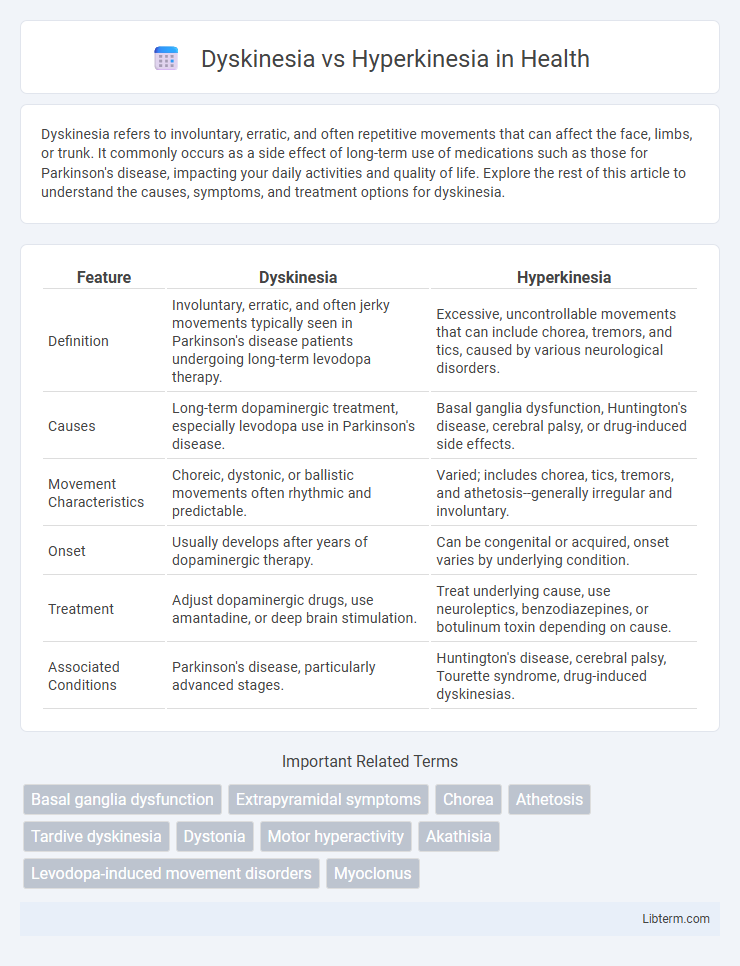Dyskinesia refers to involuntary, erratic, and often repetitive movements that can affect the face, limbs, or trunk. It commonly occurs as a side effect of long-term use of medications such as those for Parkinson's disease, impacting your daily activities and quality of life. Explore the rest of this article to understand the causes, symptoms, and treatment options for dyskinesia.
Table of Comparison
| Feature | Dyskinesia | Hyperkinesia |
|---|---|---|
| Definition | Involuntary, erratic, and often jerky movements typically seen in Parkinson's disease patients undergoing long-term levodopa therapy. | Excessive, uncontrollable movements that can include chorea, tremors, and tics, caused by various neurological disorders. |
| Causes | Long-term dopaminergic treatment, especially levodopa use in Parkinson's disease. | Basal ganglia dysfunction, Huntington's disease, cerebral palsy, or drug-induced side effects. |
| Movement Characteristics | Choreic, dystonic, or ballistic movements often rhythmic and predictable. | Varied; includes chorea, tics, tremors, and athetosis--generally irregular and involuntary. |
| Onset | Usually develops after years of dopaminergic therapy. | Can be congenital or acquired, onset varies by underlying condition. |
| Treatment | Adjust dopaminergic drugs, use amantadine, or deep brain stimulation. | Treat underlying cause, use neuroleptics, benzodiazepines, or botulinum toxin depending on cause. |
| Associated Conditions | Parkinson's disease, particularly advanced stages. | Huntington's disease, cerebral palsy, Tourette syndrome, drug-induced dyskinesias. |
Understanding Dyskinesia: Definition and Causes
Dyskinesia refers to involuntary, erratic, and often writhing movements typically caused by long-term use of dopaminergic medications in Parkinson's disease patients. It arises from abnormal dopamine signaling pathways and neurochemical imbalances within the basal ganglia, leading to disrupted motor control. Understanding dyskinesia involves recognizing its link to levodopa-induced motor complications and differentiating it from hyperkinesia, which encompasses a broader category of excessive movements including tics and chorea.
What is Hyperkinesia? Key Features Explained
Hyperkinesia is characterized by involuntary, excessive movements that disrupt normal motor control, often resulting from neurological disorders affecting the basal ganglia. Key features include rapid, repetitive muscle contractions, tremors, and uncontrolled jerking motions that can impair coordination and daily functioning. Unlike dyskinesia, which often arises as a side effect of long-term medication use in Parkinson's disease, hyperkinesia encompasses a broader range of hyperactive movement disorders.
Dyskinesia vs Hyperkinesia: Core Differences
Dyskinesia refers to involuntary, erratic, and often repetitive movements typically associated with Parkinson's disease and long-term use of levodopa, characterized by chorea, dystonia, or tics. Hyperkinesia encompasses a broader spectrum of excessive, uncontrollable movements, including tremors, myoclonus, and chorea, and can result from various neurological disorders such as Huntington's disease or cerebral palsy. The core difference lies in dyskinesia's link to medication-induced motor complications, whereas hyperkinesia describes any pathological increase in movement beyond normal voluntary activity.
Common Symptoms of Dyskinesia
Dyskinesia is characterized by involuntary, erratic, and often writhing movements, commonly affecting the face, limbs, and trunk. These movements are typically repetitive and can include chorea, athetosis, or dystonic postures, often resulting from long-term use of dopaminergic medications in Parkinson's disease. Unlike hyperkinesia, which involves excessive movement generally due to neurological disorders, dyskinesia primarily manifests as abnormal, involuntary motor activity linked to medication side effects.
Typical Signs of Hyperkinesia
Typical signs of hyperkinesia include excessive involuntary movements such as chorea, athetosis, and tics. These movements are often rapid, irregular, and purposeless, reflecting abnormal excessive motor activity. Hyperkinesia contrasts with dyskinesia, which typically involves abnormal, often drug-induced movements associated with Parkinson's disease treatments.
Underlying Neurological Mechanisms
Dyskinesia is characterized by involuntary, often repetitive movements primarily linked to dopamine dysregulation in the basal ganglia, especially in Parkinson's disease patients undergoing long-term levodopa therapy. Hyperkinesia refers to excessive or exaggerated voluntary movements caused by abnormal neuronal firing or loss of inhibitory control in motor circuits, involving structures such as the striatum, thalamus, and cortex. Both conditions result from distinct disruptions in motor pathway signaling, with dyskinesia predominantly involving dopaminergic pathways and hyperkinesia reflecting broader motor system hyperexcitability.
Diagnostic Criteria for Both Conditions
Dyskinesia is characterized by involuntary, erratic, and often repetitive movements typically associated with long-term use of dopaminergic medications, and diagnosis relies on clinical observation of these abnormal movements in conjunction with patient medication history. Hyperkinesia encompasses a broader range of excessive movement disorders, including chorea, dystonia, and tremor, diagnosed through neurologic examination and the exclusion of other causes such as metabolic or structural brain abnormalities. Both conditions require careful assessment of movement patterns, patient history, and sometimes neuroimaging or electrophysiological studies to differentiate between the specific types of involuntary movements for accurate diagnosis.
Treatment Approaches: Dyskinesia and Hyperkinesia
Treatment approaches for dyskinesia often involve medication adjustments, such as reducing or changing dopaminergic drugs in Parkinson's disease patients, and using deep brain stimulation (DBS) to modulate abnormal motor activity. In contrast, hyperkinesia treatment targets the underlying causes, employing anticonvulsants, muscle relaxants, or botulinum toxin injections to reduce involuntary movements seen in conditions like Huntington's disease or chorea. Both conditions benefit from individualized therapeutic strategies combining pharmacological interventions with physical therapy to improve motor control and quality of life.
Impact on Quality of Life
Dyskinesia, characterized by involuntary, erratic movements often linked to Parkinson's disease treatment, significantly disrupts daily activities such as walking, speaking, and eating, severely impacting quality of life. Hyperkinesia encompasses a broader range of excessive movements, including tics and chorea, which can lead to social embarrassment and physical discomfort, further diminishing emotional well-being and social interactions. Both conditions require targeted clinical management to alleviate symptoms and improve patients' functional independence and psychological health.
Managing and Preventing Motor Disorders
Effective management of dyskinesia and hyperkinesia involves tailored pharmacological treatments such as dopamine agonists for Parkinson's disease-related dyskinesia and anticholinergic agents for hyperkinesia symptoms. Preventive strategies focus on early diagnosis and optimizing medication dosages to minimize abnormal involuntary movements, alongside physical therapy to improve motor control. Regular neurological assessments and patient-specific rehabilitation plans are critical in reducing the impact of these motor disorders.
Dyskinesia Infographic

 libterm.com
libterm.com